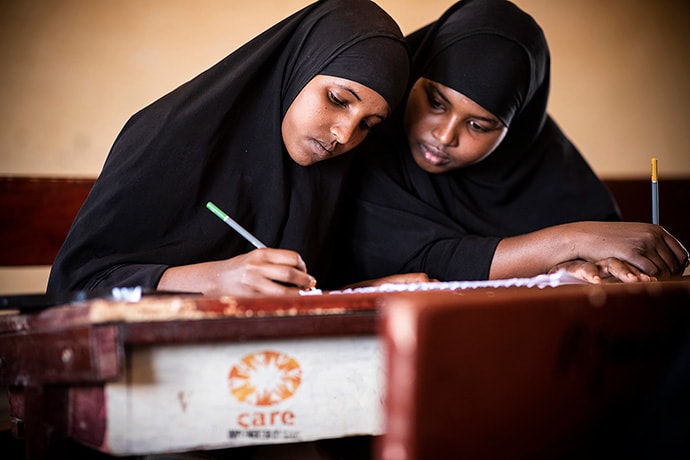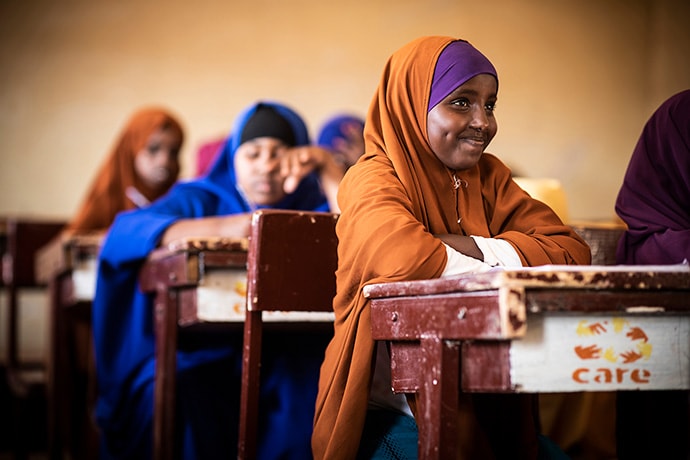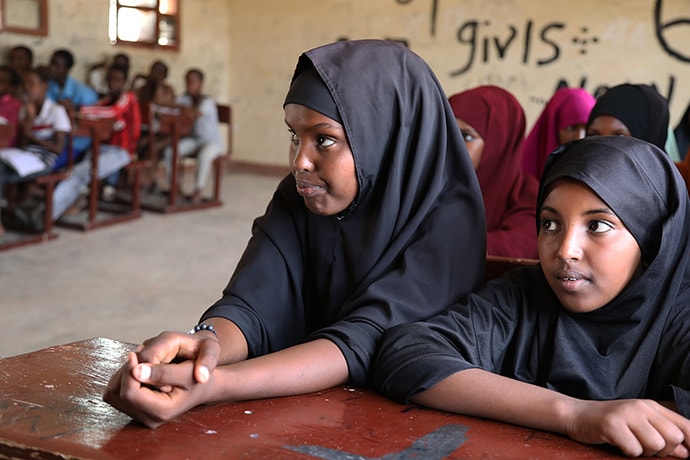By Aneesh Chatterjee

CARE Somalia photo by Toby Madden.
Founded in 1945, CARE International is a globally present NGO working to alleviate poverty in over 102 countries around the world. With a special focus on women’s empowerment, CARE has a broad range of development programming which includes education and adolescent empowerment, health and nutrition, food security and climate justice, economic opportunity, and humanitarian response.
CARE’s work reaches over 100 million people through 1,495 community-based projects that fight the root causes of poverty. From working to get more girls into school to fighting child marriage, building resilient agriculture, empowering women by diversifying livelihoods, and closing the gender gap in the global workforce, CARE’s efforts to achieve an inclusive and just future is encapsulated in their 2030 Vision, adhering to a framework of Sustainable Development Goals and exemplified by their ongoing work across the world.
To highlight CARE’s work in the education sector, showcasing their programs and successes in the field, we spoke with Amanda Moll, CARE’s Senior Advisor for Adolescent Programing, within the Education & Adolescent Empowerment Team.
1. How have the Educate Your Children II / Waxbar Carurtaada II and Somali Girls’ Education Programme – Transition (SOMGEP-T) initiatives achieved their project objectives of reducing the gender gap in Somali schools, providing quality education, facilitating learning materials and increasing transition rates?
Somalia is actually one of the countries where we have our largest portfolios, when you look at CARE’s work in education across different countries. We feel very fortunate to both have great donors and partners supporting our work.
Interventions that we’ve done under these projects that have helped us to improve educational provision include enrolment campaigns focusing on girls’ education to make sure we’re getting more children, particularly girls, enrolled in school. We’ve also reduced the gender gap among new students enrolling in schools, so that almost 50% of them are girls. This is something that we’ve worked toward a lot; if you look back five, ten, twenty years ago – it’s quite a shift that we’ve been able to see, and so that’s something that we’re really proud of.
Additionally, any new teacher training we do includes female teachers. Our work with Community Education Committees has also enhanced their awareness fo how having female teachers in classroom has a positive impact on girls. It has also increased the Committees’ allocations of local funds to pay for female teacher salaries. Over time, we hope to increase the percentage of new teachers that are female and ensure that they see it as a quality career path where they’re supported, both by the training program and the teaching profession.
The teacher training itself also focuses on gender. This includes training teachers on gender equality, inclusive strategies, and non-violent classroom management. Some examples of that would be recognizing which students teachers are calling on when they raise their hands to answer questions – are they only calling on boys, or only calling on girls? What types of questions are you asking students – are you only asking boys the hard questions, and girls, the easy questions? We ensure that when teachers give examples in the classroom, the examples are more gender inclusive. For example, when reading a short story in the class, is the doctor in the story always male, or do we have both male and female doctors in the story? As teachers are changing their teaching styles, we’ve seen them become more inclusive of all students. Both boys and girls feel they’re being treated equally, have the same opportunities, and they want to stay in school.
Other work we’re doing is at the community level. We work with school management committees (SMCs), or community education committees (CECs) in Somalia – similar to Parent Teacher Associates (PTAs) in the US. These groups are the ones monitoring teachers’ performance on a regular basis, making sure teachers and students are showing up to school each day. If a student is persistently absent, it’s usually these volunteer parents who go out and follow up with the child’s parents to find out why the child has been out of school, if they can do something to help, and to eventually reduce the risk of girls dropping out due to early marriage and to bring them back to school. They also help track which students are doing well in school, and who isn’t. With these measures in place, gender-inclusive teaching styles and an involved parent-teacher community encourages students to do well. When you’re doing well in school, and you have a community ready to support you, you’re more likely to stay in school.
Those are some of the strategies we’ve used over time to not only improve student learning outcomes, but also increase student transitions from one grade to the next.

CARE Somalia photo by Toby Madden.
2. What approaches are adopted by CARE’s Education Sector Program to address safety and security issues, train instructors, facilitate access to learning materials and support the capabilities of policymakers in putting forward legislation that strengthens the education sector in Somalia? What are some core achievements of the Education Sector Program?
A lot of the work done by the SMCs/CECs to ensure community engagement and the quality of education also focuses on safety and security issues that arise within their community. During regular meetings, for example, it may be brought up that students have to walk to school on certain roads that see transport vehicles with heavy loads that aren’t really watching out for kids, making it dangerous for them. In response, we often see that parents or other community leaders of these committees accompany the kids to increase student safety.
If there are reports of student abuse taking place, the committees – particularly mothers’ groups – are one of the first reporting mechanisms students can go to, in addition to teachers. They work to make sure that kids know who they can go to if they don’t feel safe. This is done not only at the school level, but the community level as well, building a functional mechanism to address safety and security.
In terms of strengthening the education sector more broadly, this particular project is in partnership with the Global Partnership for Education (GPE). They provide system-strengthening grants, which are transformational to education systems. There are a few strategies we’ve used when working to strengthen the sector: one is teacher-training programs. These are not only pre-service training programs, which takes place after university training but before classroom teaching, but in-service training as well. As new teaching methods are used, successful strategies are shared among new teachers; newly released curricula is also incorporated in teacher training.
Another focus is ensuring learning materials make their way to schools. A lot of what we do is making sure that the learning material is properly printed, accurate, with no missing sections, and that they’re making their way to schools for use. Additionally, through the use of school capitation grants – individual grants given to schools to implement school improvement plans developed school management committees– we help them come up with an action plan each year so that schools can achieve their developmental targets and provide opportunities for teachers.
The last thing I’ll mention is that we build relationships with others working in education. Any time we work in the education sector, especially to strengthen it, it’s never CARE in isolation. There are always more actors – developmental organizations, community groups, ministries of education – who need to be brought together, be ensured that there is an agreement among parties with no overlap, and be informed that the strategies implemented are working. Making sure that everyone’s part of that conversation is something we do to strengthen the education sector more broadly, so that the best strategies and protocols can be shared – and ones that don’t work can be addressed together.
3. What role does CARE play in developing the curricula for the education programs they facilitate?
Ultimately, the local Ministry of Education is responsible for curriculum development, because education is a public service. We never want to create a parallel track to them. Any curriculum development or reviews we do are in collaboration with the Ministries of Education. You see some of that in the system-strengthening grants, but also with some of our other programs as well, where we develop and pilot test new components of a curriculum. A new topic, activity or exercise for students that falls outside the existing mandate is still developed by cooperating with the local Ministry of Education, adhering to their standards and goals, with the hopes that the new materials may be adopted over time.
4. How has the Strengthening Opportunities for Adolescent Resilience (SOAR) program developed models for accelerated education that successfully re-integrate target groups who have been out of school for significant periods, facing increasing barriers to completing their education?
This is one of our core programs we’re implementing in multiple countries. Almost all countries where we have SOAR programming include provisions for children and adolescents who’ve previously dropped out of school. We look at the re-enrolment policies that exist for those who have dropped out, the circumstances under which they could go back, the requirements for re-entry exams, and whether they’re placed at grades appropriate to their age or their previous level of education.
A lot of the work we’ve done looks at building additional models accompanying the work local governments have done. Over an eleven-month period, we build adolescent numeracy and literacy, leadership skills, financial and digital literacy – which obviously vary from one country to the next, because we want to make sure we’re working with the local education system.
We’ve seen a lot of success with this project. In terms of transition rates, we observe the number of students who start the program compared to those who finish it. Usually, an exam is required to transition back into formal school, so we observe how many of them make that transition. In India, for example, 95% of girls who go through our program transition into formal school. In Zambia, 79% of SOAR graduates transition back into formal school successfully; in 75% in Nepal, 73% in Somalia and 56% in Malawi.
Working with adolescents, we also look at direct re-enrolment to go straight back to formal school. Generally, those between 15-18 years who earlier dropped out of school struggle to catch-up and transition back to school at the same grade as their peers; they are more likely to transition into a lower grade in school. We recognize this and acknowledge that formal school isn’t the only direction following the program. Sometimes, success is also going into a technical or vocational training program. Some of them also choose to go directly into work, but now the work they choose is more meaningful, with more options and opportunities to increase income and have safer working environments. We want to recognize that no one path fits every single person, but our goal is to make sure they have the ability to make an informed choice.
5. The Patsy Collins Trust Fund Initiative (PCTFI) addresses a range of issues impacting marginalized girls in Somalia, including formal education, reproductive health, leadership training and financial literacy. How does the Initiative develop models to tackle these issues? How has the PCTFI been successful?
The gift we received from Patsy Collins in 2003 has been a foundational piece in guiding CARE’s education work over the last nineteen years. Some of the work we’ve done across over 18 countries – focusing on individual, community and policy-level development – has aimed to reach children and adolescents both in and out of school, with a strong focus on connecting with marginalized girls. Our in-school programs focus on curriculum development, parent committees, and teacher training. Out-of-school programs also facilitate extracurricular activities for students.
We’ve developed curriculum materials which include real-world scenarios, which is what makes education real. For example, we’ve included financial literacy in some of our programs, which focuses on applied math. Students may learn basic arithmetic, but not necessarily how that could be applied to calculate profit or loss, or building saving skills and making informed financial decisions. Practical application is something that we look at. Sometimes it’s integrated within classrooms, and sometimes in extracurricular activities. Extracurricular savings clubs, such as the Adolescent Youth Loans and Savings Association, are groups where they come together as collectives to save small amounts contributed over time. Sometimes they’ll do projects where people can get loans from the group savings account, building habits for better financial literacy.
The other big project we’ve built through this program is our leadership development model, which has been used in our education programing since 2008. It essentially looks at building individual leadership competencies such as decision-making skills, negotiating tactics, identifying problems and generating solutions. A lot of that requires real-world applications and safe spaces to practice their skills, which we’ve worked on. Because we’ve used this model for so many years, we have evidence on what it means over time. For example, we’ve seen that students with higher self-perception of leadership competencies have significantly higher learning outcomes. The more they feel they’re building leadership skills effectively, the better they perform in school. Kids have higher learning outcomes, are more likely to stay in school, and reflect higher transition rates, as a result of participating in activities which include leadership development.
6. How has the Azraq Film School enabled young refugees to learn the technical skills and storytelling prowess required to tell their stories?
A lot of the youth that went through that program not only learned technical skills like operating cameras and using editing software, but they also strengthened their skills around their storytelling process. It shifted the storytelling center of power to them, so it wasn’t someone else telling their story. They could determine the narrative. Creating that space and providing those supportive outlets to practice and apply those skills, pushing comfort zones, enabled them to learn the most. A lot of filmmakers and storytellers who went through that program built a lot of those skills, and were granted access to the technology, materials and equipment, and given the opportunity to take that experience wherever they wanted.

7. What implementation challenges have been faced while working to establish education programs in regions prone to conflict and droughts, with geographically remote target populations? How does CARE partner with other institutions, governments and local communities to tackle these challenges?
A lot of CARE’s work prioritizes marginalized communities, which aren’t always easy to access. Multiple challenges can compound on one another. Our work aims on reaching the hardest to reach by working with partner organizations, which are some of our strongest assets. We work with local organizations and movements.
After the start of the war in Ukraine, for example, we’ve identified local grassroots organizations that we can support directly through financial means and training. Now, we’re able to support work across Ukraine, which applies not only in a humanitarian context, but developmental as well. We work with non-profits, local religious organizations, youth-led groups, and other types of actors to build networks. We find that they often have strong ties to the specific needs of their communities, and we want to partner with them.
Another strategy we use is working within the specific context of whatever region we operate in. For example, if there are droughts, cyclones or other crises that have destroyed infrastructure, or if there has been forced migration – whatever the context is, we work within that. For education, that might mean we try to implement more flexible programs and schedules. We might work to align school calendars with farming schedules that match with migratory patterns. We may proposed schools adjust the exam period to avoid the harvest period so that school doesn’t conflict with farming operations.
We do a lot of work within the education networks and working groups within countries that bring together the actors needed to influence education – ministries, international organizations like CARE or UNICEF, religious groups, volunteers – to make sure that efforts are coordinated, strategies aren’t duplicated, and communities and the children in them know what options they have.